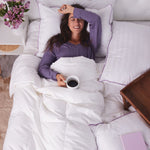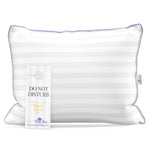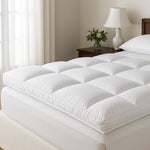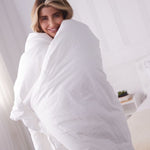You have no items in your shopping cart.

Imagine waking suddenly in the night, thrashing in your bed while gasping for air. For those with sleep apnea, this is a regular and distressing occurrence. It is also upsetting for those sharing your home, whose own sleep can be interrupted by the alarming sights and sounds of a loved one struggling to breathe. Loud frequent snoring is another common symptom of sleep apnea; though less scary, this side-effect is also disruptive to the sleep of the snorer and anyone within earshot.
What is sleep apnea?
Sleep apnea is a condition in which the sleeper’s airway is obstructed, leading to snoring, interrupted breathing, and a lack of oxygen. It affects more than 18 million American adults. It can happen to anyone, but risk factors are largely determined by genetics, the size and shape of the head and neck, body weight, and age. Of the two types of sleep apnea, the most common is OSA (Obstructive Sleep Apnea), in which airway blockage occurs due to the collapse of soft tissue in the throat. (The less common variety, Central Sleep Apnea, is caused by a malfunction in the brain’s respiratory control center.)
How is sleep apnea treated?
A diagnosis of sleep apnea can be made by a sleep specialist, who may then prescribe treatment such as a CPAP machine. Even if your condition is not severe enough to require CPAP, the doctor is also likely to recommend you try sleeping in a different position.
The importance of sleep positions.
Numerous studies have shown that the position of your body while asleep makes a significant difference in the incidence and severity of sleep apnea episodes.
Prone (lying on stomach) – This position is most frequently recommended for severe sleep apnea. A study found that sleeping in a prone position has a significantly beneficial effect on the severity of the disease in patients with OSA.
Side – Though prone sleeping is best, side-sleeping is still preferable to lying on one’s back. Another study shows that Apnea Hypopnia Index (AHI), which is used to measure the severity of OSA, is twice as high when the patient lies on their back as opposed to their side.
Elevated – If sleeping on your back is the only option, there are still ways to minimize risk while enhancing comfort. This usually involves elevating the upper half of your body into a reclining position. Some mattresses are fully adjustable, or you can make do with the right pillows. Elevated sleeping can also help alleviate snoring by keeping airways upright and open
The right pillow makes all the difference.
Is back and neck pain ruining sleep for you or a loved one? Check out our high loft LoftKing by Queen Anne Pillow Company! It might be just what you need. Better health starts with better sleep.
- 100% Cotton Ticking
- Hypoallergenic
- Elevated Support Made in the USA
- High-Loft for Extra Firm Neck and Shoulder Support
- Incline Position to Help Alleviate Snoring
Adjusting to a new sleeping position can be tough. Most of us have long ago adapted to a preferred position, and changing our habits can be a real challenge. You may find yourself waking frequently due to soreness and discomfort, and end up feeling just as tired and worn out in the morning as you were before. Fortunately, a high-quality Queen Anne pillow can help you adapt to the modified sleep position that works best for you, enabling you to change your sleeping habits for the long term and improve your overall health.
Prone – Two of the biggest complaints of sleeping in the prone position are neck soreness and facial irritation due to constant contact with the pillow. The Duke provides just the right loft, firmness, and bounce to align the posture of prone sleepers, making them as comfortable as possible. The hypoallergenic material improves sleep by keeping airways free of histamine-triggering allergens, while also being non-irritating to the skin.
Side – When sleeping on your side, proper alignment of the neck and spine is critical. The scientifically designed Heavenly Down can ensure that you awaken feeling refreshed and free of soreness. In fact, it is commonly used in luxury hotels and on cruise ships to help guests feel pampered and well-rested.
Elevated – If you must sleep on your back, the LoftKing is the way to go. This ultra-firm pillow is designed to support the neck and shoulders while opening up the airways for unrestricted breathing and reduced snoring.
Though sleep apnea is a disturbing thing to experience or witness, its effects can be minimized by treatment and through conscientious adjustments to waking and sleeping habits. Queen Anne pillows can be a crucial component of your adaptation to the disorder, enabling you to finally get the restful sleep you deserve. Contact us today!

Imagine waking suddenly in the night, thrashing in your bed while gasping for air. For those with sleep apnea, this is a regular and distressing occurrence. It is also upsetting for those sharing your home, whose own sleep can be interrupted by the alarming sights and sounds of a loved one struggling to breathe. Loud frequent snoring is another common symptom of sleep apnea; though less scary, this side-effect is also disruptive to the sleep of the snorer and anyone within earshot.
What is sleep apnea?
Sleep apnea is a condition in which the sleeper’s airway is obstructed, leading to snoring, interrupted breathing, and a lack of oxygen. It affects more than 18 million American adults. It can happen to anyone, but risk factors are largely determined by genetics, the size and shape of the head and neck, body weight, and age. Of the two types of sleep apnea, the most common is OSA (Obstructive Sleep Apnea), in which airway blockage occurs due to the collapse of soft tissue in the throat. (The less common variety, Central Sleep Apnea, is caused by a malfunction in the brain’s respiratory control center.)
How is sleep apnea treated?
A diagnosis of sleep apnea can be made by a sleep specialist, who may then prescribe treatment such as a CPAP machine. Even if your condition is not severe enough to require CPAP, the doctor is also likely to recommend you try sleeping in a different position.
The importance of sleep positions.
Numerous studies have shown that the position of your body while asleep makes a significant difference in the incidence and severity of sleep apnea episodes.
Prone (lying on stomach) – This position is most frequently recommended for severe sleep apnea. A study found that sleeping in a prone position has a significantly beneficial effect on the severity of the disease in patients with OSA.
Side – Though prone sleeping is best, side-sleeping is still preferable to lying on one’s back. Another study shows that Apnea Hypopnia Index (AHI), which is used to measure the severity of OSA, is twice as high when the patient lies on their back as opposed to their side.
Elevated – If sleeping on your back is the only option, there are still ways to minimize risk while enhancing comfort. This usually involves elevating the upper half of your body into a reclining position. Some mattresses are fully adjustable, or you can make do with the right pillows. Elevated sleeping can also help alleviate snoring by keeping airways upright and open
The right pillow makes all the difference.
Is back and neck pain ruining sleep for you or a loved one? Check out our high loft LoftKing by Queen Anne Pillow Company! It might be just what you need. Better health starts with better sleep.
- 100% Cotton Ticking
- Hypoallergenic
- Elevated Support Made in the USA
- High-Loft for Extra Firm Neck and Shoulder Support
- Incline Position to Help Alleviate Snoring
Adjusting to a new sleeping position can be tough. Most of us have long ago adapted to a preferred position, and changing our habits can be a real challenge. You may find yourself waking frequently due to soreness and discomfort, and end up feeling just as tired and worn out in the morning as you were before. Fortunately, a high-quality Queen Anne pillow can help you adapt to the modified sleep position that works best for you, enabling you to change your sleeping habits for the long term and improve your overall health.
Prone – Two of the biggest complaints of sleeping in the prone position are neck soreness and facial irritation due to constant contact with the pillow. The Duke provides just the right loft, firmness, and bounce to align the posture of prone sleepers, making them as comfortable as possible. The hypoallergenic material improves sleep by keeping airways free of histamine-triggering allergens, while also being non-irritating to the skin.
Side – When sleeping on your side, proper alignment of the neck and spine is critical. The scientifically designed Heavenly Down can ensure that you awaken feeling refreshed and free of soreness. In fact, it is commonly used in luxury hotels and on cruise ships to help guests feel pampered and well-rested.
Elevated – If you must sleep on your back, the LoftKing is the way to go. This ultra-firm pillow is designed to support the neck and shoulders while opening up the airways for unrestricted breathing and reduced snoring.
Though sleep apnea is a disturbing thing to experience or witness, its effects can be minimized by treatment and through conscientious adjustments to waking and sleeping habits. Queen Anne pillows can be a crucial component of your adaptation to the disorder, enabling you to finally get the restful sleep you deserve. Contact us today!








